-
1 of 253523 objects
'Holmes's Bonfire', the burning of Dutch Merchant Ships between Terschelling and Vlieland, 19th August 1666 Signed and dated 1676
Oil on canvas | 126.3 x 182.7 x 3.8 cm (support, canvas/panel/stretcher external) | RCIN 406560

Willem van de Velde the Elder (1611-93)
'Holmes's Bonfire', the burning of Dutch Merchant Ships between Terschelling and Vlieland, 19th August 1666 Signed and dated 1676
-
Upon the Restoration in 1660 Charles II appointed his brother, James, Duke of York (later James II), to the position of Lord High Admiral, in which capacity he commanded the Royal Navy during the Second (1665-7) and Third (1672-4) Anglo-Dutch Wars [the First (1652-4) took place in Cromwell's time]. The series of conflicts with the Dutch Republic errupted over control of trade routes and colonies.
In 1675 the Duke of York commissioned from the recently-arrived Dutch artists, father and son, Willem van de Velde the Elder and Willem van de Velde the Younger, a set of 12 large canvases depicting naval battles and incidents in these two conflicts and the ongoing struggle against the Barbary Corsairs. Previous commissions of this type had been for tapestries, like the famous Armada set hanging at this date in the House of Lords. The Van de Veldes' paintings in this series have the character of tapestries, with high view points and a crowding of incidents, as opposed to the sea-level, atmospheric views of their other oil paintings, such as The 'Royal Escape' in a Breeze. Most of the paintings in this set show a degree of collaboration between father and son, although these two are predominantly by van de Velde the Younger. It is likely that the Van de Veldes were involved in a commission from Charles II for a series of tapestry designs to commemorate the battle of Solebay in 1672, which were executed by the Mortlake tapestry works.
Holmes's Bonfire portrays the raid on Vlieland and Terschelling, two of the West Frisian islands at the northern extremity of the Netherlands. The foray took place on 19 August 1666, shortly after the defeat of the Dutch at the battle of St James's Day (4 August 1666). With a small squadron, Sir Robert Holmes attacked a large fleet of about 170 merchant ships; over 100 ships were burnt, together with the village of West Terschelling. The conflagration is viewed from the North Sea, looking south through the strait between the two islands. Although the attacks took place on two consecutive days, the artist has depicted both in one picture.
Inscribed lower right: 'W. V. Velde' and on the reverse of the canvas: 'W, V. Velde 1676.'
Text adapted from Charles II: Art and Power, London, 2017.Provenance
Commissioned by James II, when Duke of York
-
Creator(s)
Acquirer(s)
-
Medium and techniques
Oil on canvas
Measurements
126.3 x 182.7 x 3.8 cm (support, canvas/panel/stretcher external)
142.4 x 198.9 x 5.2 cm (frame, external)
Category
Object type(s)
Other number(s)
Alternative title(s)
The Burning of Dutch Merchant Ships between Terschelling and Vlieland, 19th August 1666